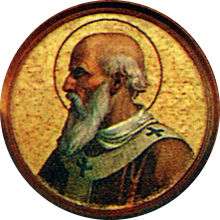Pope Leo II
| Pope Saint Leo II | |
|---|---|
 | |
| Papacy began | 17 August 682 |
| Papacy ended | 28 June 683 |
| Predecessor | Agatho |
| Successor | Benedict II |
| Personal details | |
| Birth name | Leo Maneius |
| Born |
611 Sicily, Byzantine Empire |
| Died |
28 June 683 Rome, Byzantine Empire |
| Papal styles of Pope Leo II | |
|---|---|
 | |
| Reference style | His Holiness |
| Spoken style | Your Holiness |
| Religious style | Holy Father |
| Posthumous style | Saint |
Pope Saint Leo II (611 – 28 June 683) was Pope from 17 August 682 to 28 June 683.[1] He is one of the popes of the Byzantine Papacy.
Background and early activity in the Church
He was a Sicilian by birth (the son of a man named Paulus). He may have ended up being among the many Sicilian clergy in Rome, at that time, due to the Islamic Caliphate battles against Sicily in the mid-7th century.[2] Though elected pope a few days after the death of Pope St. Agatho (10 January 681), he was not consecrated till after the lapse of a year and seven months (17 August 682).[1] Leo was known as an eloquent preacher who was interested in music, and noted for his charity to the poor.[3]
Reign as Bishop of Rome
Elected shortly after the death of Agatho, Leo was not consecrated for over a year and a half. The reason may have been due to negotiations regarding imperial control of papal elections.[4]
These negotiations were undertaken by Leo's predecessor Agatho between the Holy See and Emperor Constantine IV. They concerned the relations of the Byzantine Court to papal elections. Constantine IV had already promised Agatho to abolish or reduce the tax that the popes had been paying to the imperial treasury at the time of their consecration, an imperial policy that had been in force for about a century.[1]
Leo's short-lived pontificate did not allow him to accomplish much, but there was one achievement of major importance: he confirmed the acts of the Sixth Ecumenical Council (680–681). This council had been held in Constantinople against the Monothelite controversy, and had been presided over by the legates of Pope Agatho. After Leo had notified the Emperor that the decrees of the council had been confirmed, he made them known to the nations of the West. In letters written to the king, the bishops, and the nobles of Spain, he explained what the council had effected, and he called upon the bishops to subscribe to its decrees.[1]
During this council, Pope Honorius I was anathematized for his views in the Monothelite controversy as tolerant of heresy.[5] Leo took great pains to make it clear that in condemning Honorius, he did so not because Honorius taught heresy, but because he was not active enough in opposing it. In accordance with the papal mandate, a synod was held at Toledo (684) in which the Third Council of Constantinople was accepted.[5]
Regarding the decision of the council, Leo wrote once and again in approbation of the decision of the council and in condemnation of Honorius, whom he regarded as one who profana proditione immaculatem fidem subvertare conatus est (roughly, "one who by betrayal has tried to overthrow the immaculate faith"). In their bearing upon the question of papal infallibility these words have caused considerable attention and controversy, and prominence is given to the circumstance that in the Greek text of the letter to the Emperor which the phrase occurs, the milder expression subverti permisit ("allowed to be overthrown...") is used for subvertare conatus est.[5]
At this time, Leo put an end to the attempts of the Ravenna archbishops to get away from the control of the Bishop of Rome. The Pope sweetened the deal for the Ravenna bishops by abolishing the tax it had been customary for them to pay when they received the pallium.[6]
Also, in apparent response to Lombard raids, Leo transferred the relics of a number of martyrs from the catacombs to churches inside the walls of the city. He also dedicated two churches, St. Paul's and Sts. Sebastian and George.[6]
Burial
Leo was originally buried in his own monument; however, some years after his death, his remains were put into a tomb that contained the first four of his papal namesakes.[7]
See also
References
- 1 2 3 4
 Herbermann, Charles, ed. (1913). "Pope St. Leo II". Catholic Encyclopedia. New York: Robert Appleton Company.
Herbermann, Charles, ed. (1913). "Pope St. Leo II". Catholic Encyclopedia. New York: Robert Appleton Company. - ↑ Jeffrey Richards (1 May 2014). The Popes and the Papacy in the Early Middle Ages: 476-752. Routledge. p. 270. ISBN 9781317678175.
- ↑ Saints
- ↑ Delay
- 1 2 3 Heresy
- 1 2 Popes
- ↑ Reardon, Wendy (McFarland). The deaths of the Popes. Check date values in:
|date=(help)
| Catholic Church titles | ||
|---|---|---|
| Preceded by Agatho |
Pope 682–683 |
Succeeded by Benedict II |

